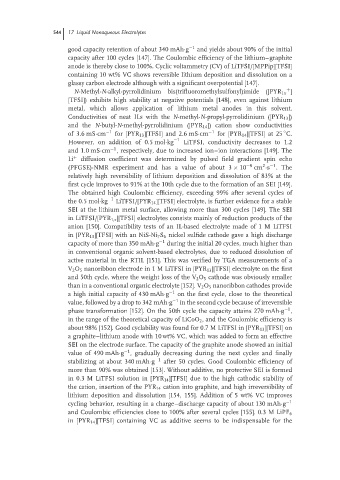Page 570 - Handbook of Battery Materials
P. 570
544 17 Liquid Nonaqueous Electrolytes
good capacity retention of about 340 mAh·g −1 and yields about 90% of the initial
capacity after 100 cycles [147]. The Coulombic efficiency of the lithium–graphite
anode is thereby close to 100%. Cyclic voltammetry (CV) of LiTFSI/[MPPip][TFSI]
containing 10 wt% VC shows reversible lithium deposition and dissolution on a
glassy carbon electrode although with a significant overpotential [147].
N-Methyl-N-alkyl-pyrrolidinium bis(trifluoromethylsulfonyl)imide ([PYR 1x ]
+
[TFSI]) exhibits high stability at negative potentials [148], even against lithium
metal, which allows application of lithium metal anodes in this solvent.
Conductivities of neat ILs with the N-methyl-N-propyl-pyrrolidinium ([PYR 13 ])
and the N-butyl-N-methyl-pyrrolidinium ([PYR 14 ]) cation show conductivities
◦
of 3.6mS·cm −1 for [PYR 13 ][TFSI] and 2.6mS·cm −1 for [PYR 14 ][TFSI] at 25 C.
−1
However, on addition of 0.5 mol·kg LiTFSI, conductivity decreases to 1.2
−1
and 1.0mS·cm , respectively, due to increased ion–ion interactions [149]. The
Li + diffusion coefficient was determined by pulsed field gradient spin echo
−1
2
(PFGSE)-NMR experiment and has a value of about 3 × 10 −8 cm ·s .The
relatively high reversibility of lithium deposition and dissolution of 83% at the
first cycle improves to 91% at the 10th cycle due to the formation of an SEI [149].
The obtained high Coulombic efficiency, exceeding 99% after several cycles of
the 0.5mol·kg −1 LiTFSI/[PYR 14 ][TFSI] electrolyte, is further evidence for a stable
SEI at the lithium metal surface, allowing more than 300 cycles [149]. The SEI
in LiTFSI/[PYR 1,x ][TFSI] electrolytes consists mainly of reduction products of the
anion [150]. Compatibility tests of an IL-based electrolyte made of 1 M LiTFSI
in [PYR 13 ][TFSI] with an NiS-Ni 7 S 6 nickel sulfide cathode gave a high discharge
capacity of more than 350 mAh·g −1 during the initial 20 cycles, much higher than
in conventional organic solvent-based electrolytes, due to reduced dissolution of
active material in the RTIL [151]. This was verified by TGA measurements of a
V 2 O 5 nanoribbon electrode in 1 M LiTFSI in [PYR 13 ][TFSI] electrolyte on the first
and 50th cycle, where the weight loss of the V 2 O 5 cathode was obviously smaller
than in a conventional organic electrolyte [152]. V 2 O 5 nanoribbon cathodes provide
a high initial capacity of 430 mAh·g −1 on the first cycle, close to the theoretical
value, followed by a drop to 342 mAh·g −1 in the second cycle because of irreversible
−1
phase transformation [152]. On the 50th cycle the capacity attains 270 mAh·g ,
in the range of the theoretical capacity of LiCoO 2 , and the Coulombic efficiency is
about 98% [152]. Good cyclability was found for 0.7 M LiTFSI in [PYR 13 ][TFSI] on
a graphite–lithium anode with 10 wt% VC, which was added to form an effective
SEI on the electrode surface. The capacity of the graphite anode showed an initial
−1
value of 490 mAh·g , gradually decreasing during the next cycles and finally
stabilizing at about 340 mAh·g −1 after 50 cycles. Good Coulombic efficiency of
more than 90% was obtained [153]. Without additive, no protective SEI is formed
in 0.3 M LiTFSI solution in [PYR 14 ][TFSI] due to the high cathodic stability of
the cation, insertion of the PYR 14 cation into graphite, and high irreversibility of
lithium deposition and dissolution [154, 155]. Addition of 5 wt% VC improves
cycling behavior, resulting in a charge–discharge capacity of about 130 mAh·g −1
and Coulombic efficiencies close to 100% after several cycles [155]. 0.3 M LiPF 6
in [PYR 14 ][TFSI] containing VC as additive seems to be indispensable for the

